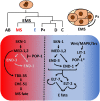Evolution and Developmental System Drift in the Endoderm Gene Regulatory Network of Caenorhabditis and Other Nematodes
- PMID: 32258041
- PMCID: PMC7093329
- DOI: 10.3389/fcell.2020.00170
Evolution and Developmental System Drift in the Endoderm Gene Regulatory Network of Caenorhabditis and Other Nematodes
Abstract
Developmental gene regulatory networks (GRNs) underpin metazoan embryogenesis and have undergone substantial modification to generate the tremendous variety of animal forms present on Earth today. The nematode Caenorhabditis elegans has been a central model for advancing many important discoveries in fundamental mechanistic biology and, more recently, has provided a strong base from which to explore the evolutionary diversification of GRN architecture and developmental processes in other species. In this short review, we will focus on evolutionary diversification of the GRN for the most ancient of the embryonic germ layers, the endoderm. Early embryogenesis diverges considerably across the phylum Nematoda. Notably, while some species deploy regulative development, more derived species, such as C. elegans, exhibit largely mosaic modes of embryogenesis. Despite the relatively similar morphology of the nematode gut across species, widespread variation has been observed in the signaling inputs that initiate the endoderm GRN, an exemplar of developmental system drift (DSD). We will explore how genetic variation in the endoderm GRN helps to drive DSD at both inter- and intraspecies levels, thereby resulting in a robust developmental system. Comparative studies using divergent nematodes promise to unveil the genetic mechanisms controlling developmental plasticity and provide a paradigm for the principles governing evolutionary modification of an embryonic GRN.
Keywords: Caenorhabditis; developmental hourglass; developmental system drift; plasticity; robustness.
Copyright © 2020 Ewe, Torres Cleuren and Rothman.
Figures


Similar articles
-
Extensive intraspecies cryptic variation in an ancient embryonic gene regulatory network.Elife. 2019 Aug 15;8:e48220. doi: 10.7554/eLife.48220. Elife. 2019. PMID: 31414984 Free PMC article.
-
Natural cryptic variation in epigenetic modulation of an embryonic gene regulatory network.Proc Natl Acad Sci U S A. 2020 Jun 16;117(24):13637-13646. doi: 10.1073/pnas.1920343117. Epub 2020 Jun 1. Proc Natl Acad Sci U S A. 2020. PMID: 32482879 Free PMC article.
-
Stressful development: integrating endoderm development, stress, and longevity.Dev Biol. 2021 Mar;471:34-48. doi: 10.1016/j.ydbio.2020.12.002. Epub 2020 Dec 8. Dev Biol. 2021. PMID: 33307045 Review.
-
Evolutionary Dynamics of the SKN-1 → MED → END-1,3 Regulatory Gene Cascade in Caenorhabditis Endoderm Specification.G3 (Bethesda). 2020 Jan 7;10(1):333-356. doi: 10.1534/g3.119.400724. G3 (Bethesda). 2020. PMID: 31740453 Free PMC article.
-
From "the Worm" to "the Worms" and Back Again: The Evolutionary Developmental Biology of Nematodes.Genetics. 2018 Oct;210(2):397-433. doi: 10.1534/genetics.118.300243. Genetics. 2018. PMID: 30287515 Free PMC article. Review.
Cited by
-
Primordial Germ Cell Specification in Vertebrate Embryos: Phylogenetic Distribution and Conserved Molecular Features of Preformation and Induction.Front Cell Dev Biol. 2021 Sep 16;9:730332. doi: 10.3389/fcell.2021.730332. eCollection 2021. Front Cell Dev Biol. 2021. PMID: 34604230 Free PMC article. Review.
-
Robustness and innovation in synthetic genotype networks.Nat Commun. 2023 Apr 28;14(1):2454. doi: 10.1038/s41467-023-38033-3. Nat Commun. 2023. PMID: 37117168 Free PMC article.
-
The GRN concept as a guide for evolutionary developmental biology.J Exp Zool B Mol Dev Evol. 2023 Mar;340(2):92-104. doi: 10.1002/jez.b.23132. Epub 2022 Mar 28. J Exp Zool B Mol Dev Evol. 2023. PMID: 35344632 Free PMC article.
-
A synthetic synthesis to explore animal evolution and development.Philos Trans R Soc Lond B Biol Sci. 2022 Jul 18;377(1855):20200517. doi: 10.1098/rstb.2020.0517. Epub 2022 May 30. Philos Trans R Soc Lond B Biol Sci. 2022. PMID: 35634925 Free PMC article. Review.
-
Opinion: What do rescue experiments with heterologous proteins tell us and what not?Parasitol Res. 2022 Apr;121(4):1131-1135. doi: 10.1007/s00436-021-07247-z. Epub 2021 Aug 5. Parasitol Res. 2022. PMID: 34351494 Free PMC article.
References
-
- Alcorn M. R., Callander D. C., López-Santos A., Cleuren Y. N. T., Birsoy B., Joshi P. M., et al. (2016). Heterotaxy in Caenorhabditis: widespread natural variation in left – right arrangement of the major organs. Philos. Trans. R. Soc. B Biol. Sci. 371:20150404. 10.1098/rstb.2015.0404 - DOI - PMC - PubMed
Publication types
Grants and funding
LinkOut - more resources
Full Text Sources
Miscellaneous

